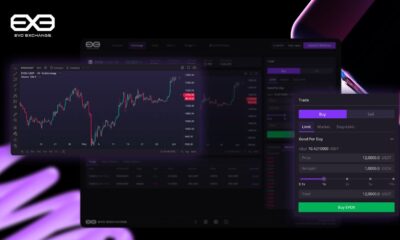Bitcoin
Katana Foundation Launches Private Mainnet for Innovative DeFi Solutions with KAT Token Rewards

Katana Foundation has officially launched its private mainnet, marking a significant step towards democratizing decentralized finance (DeFi) for varied user demographics. This non-profit organization is focused on providing an advanced DeFi experience characterized by superior yield generation and robust liquidity. Designed explicitly with DeFi applications in mind, Katana aims to maximize productivity from each asset, facilitating a continuously rewarding environment for participants.
In contrast to the often fragmented landscape of DeFi, Katana consolidates liquidity across a select number of protocols, thereby optimizing yield capture to create a self-sustaining DeFi engine poised for long-term success. Currently, pre-deposit options are available, incentivizing early adopters with KAT tokens, while a broader public mainnet launch is anticipated for the upcoming months.
Born from the collaboration between GSR and Polygon Labs, Katana is strengthened by various strategic partnerships that enhance its infrastructure. Notably, Conduit, a leading rollup platform with over $4.3 billion in Total Value Locked (TVL), and Chainlink, the foremost decentralized oracle network offering secure data feeds, are vital contributors to the ecosystem. In addition, Blockworks, a premier provider of crypto media and data, will support the development of content and analytics throughout the platform.
Katana’s user-centric approach caters to DeFi enthusiasts by providing access to heightened yields and enabling users to compose innovative "lego" DeFi strategies in an environment finely tuned for optimal returns. The architecture of Katana ensures that each asset taps into increased value, thus unlocking hidden potential through a cohesive ecosystem that consistently outshines its competitors.
Despite the maturation of DeFi markets drawing interest from institutional investors, the space still faces challenges, particularly concerning segmented liquidity and value leakage. Katana counters these issues by focusing on maintaining a rich liquidity pool, thereby minimizing slippage and stabilizing both borrowing and lending rates.
Institutions recognize the importance of robust partnerships in the DeFi realm. Since its inception, Katana has been bolstered by GSR and Polygon Labs, two titans in the industry. GSR takes an active role in managing liquidity and facilitating cross-chain functionalities while also incubating novel DeFi protocols through its ventures division. Polygon Labs, in collaboration with GSR, has provided strategic insights, technical assistance, and alignment across the ecosystem during development, particularly under the Agglayer Breakout Program.
"We take pride in Katana; our involvement highlights our dedication to incubation and advisory services," stated Jakob Palmstierna, President of GSR. "We aim to create sustainable and accessible DeFi ecosystems. Katana is a practical manifestation of our efforts to harness market knowledge to generate tangible yields and concentrated liquidity," he emphasized.
Marc Boiron, CEO of Polygon Labs, echoed this sentiment by underscoring the necessity for DeFi platforms to deliver sustainable liquidity and genuine yields. "Katana’s innovative approach transforms inefficiencies into strategic advantages, cultivating a beneficial environment for both creators and participants."
The technical framework of Katana is anchored in cdk-opgeth, a customized OP Stack integrated with Agglayer and bolstered by Zero-Knowledge (ZK) proofs. This infrastructure allows developers to work with familiar tools while providing users with increased security and rapid transaction finality. ZK proofs are efficiently generated through Succinct’s SP1 verifier utilizing Polygon’s Plonky3 zkVM, benefiting from Conduit’s G2 Sequencer as part of the network’s operational framework.
Katana significantly enhances liquidity for its user base by pooling assets across select premier DeFi products, which results in superior efficiency, reduced slippage, and competitive rates compared to other platforms. The core participants within this ecosystem include:
- Morpho: Specializing in optimized lending and borrowing solutions.
- Sushi: Known for deep spot liquidity and aggregation-based trading.
- Vertex: Engaged in capital-efficient trading of perpetual contracts.
Furthermore, developers can harness Katana’s concentrated liquidity to create solutions. By grouping similar-function assets—like stablecoins, BTC, and ETH—into strategic pools, the system achieves even more profound liquidity. For instance, Agora issues the AUSD stablecoin, while Lombard offers LBTC, a yield-bearing BTC variant pegged at a 1:1 ratio. Additionally, Ether.Fi has developed weETH, which allows holders to earn staking rewards, alongside supplementary yield via restaking opportunities.
The infrastructure also aims to facilitate non-native blue-chip assets, such as XRP, SOL, and SUI, through Universal, which enables on-chain trading and access to liquid-staked versions of these tokens, further expanding opportunities for arbitrage and farming.
To maximize yields effectively, Katana is built on five fundamental pillars:
- VaultBridge: It allows bridged assets to accumulate yield on Ethereum, ensuring productive liquidity from the onset.
- Reinvested Fees & App Revenues: The network carefully directs fees and revenues back into liquidity and growth incentives, thereby benefiting users.
- AUSD Profit Sharing: This stablecoin shares its income with the broader ecosystem, significantly enhancing user returns.
- App-Level Incentives: Core applications distribute tokens to boost incentives, yielding greater liquidity throughout the network.
- KAT Token Launch: KAT token holders govern future emission allocations, sharing governance and benefits derived from the system’s growth.
These structural components guarantee that as Katana’s network expands and bridged asset volumes increase, user yields will advance sustainably while maintaining liquidity stability even amidst market fluctuations.
Katana’s Total Value Locked (TVL) is strategically allocated across lending, trading, and yield strategies. Unlike other chains, where idling assets may distort metrics, Katana focuses on generating real yields through its core applications and third-party developments.
Moreover, Katana introduces a vote-escrow model for its KAT token to align incentives with users. KAT can be earned through free "lootbox" raffles by pre-depositing ETH, USDC, USDT, or WBTC, with potential lock periods extending up to nine months. Participants converting KAT into veKAT gain voting power regarding emission allocations for core applications, ensuring that rewards flow to protocols that stimulate genuine liquidity and network expansion.
With the private mainnet already operational, Katana invites developers and early users to explore its core applications. Interested parties are encouraged to participate at katana.network, heralding a new chapter in the DeFi landscape where efficiency and accessibility converge.
-

 Press Releases1 year ago
Press Releases1 year agoGaming Technologies of the New Time!
-

 Altcoins10 months ago
Altcoins10 months agoBitcoin Declines Below $80K: deVere CEO Nigel Green Remains Bullish on Long-Term Outlook Following Strategic U.S. Bitcoin Reserve Announcement
-

 Bitcoin1 year ago
Bitcoin1 year agoBitcoin Surges Past $64K as SEI and POPCAT Lead Daily Crypto Gains on September 25
-

 Altcoins9 months ago
Altcoins9 months agoCalls for Enhanced Discussion on Bitcoin as Brazil’s Reserve Asset: A Move Towards ‘Internet’s Gold’
-

 Press Releases2 years ago
Press Releases2 years agoEvo Exchange: Redefining the Decentralized Exchange Landscape
-

 Bitcoin5 months ago
Bitcoin5 months agoGrayscale Investments Submits Draft Registration for IPO, Aiming for Public Trading in U.S.
-

 Press Releases1 year ago
Press Releases1 year agoCODE, a Newly Born Project Brings Decentralization Back to the Main Menu
-

 Bitcoin5 months ago
Bitcoin5 months agoPeter Schiff Critiques New Crypto Legislation, Claims Bitcoin (BTC) Gains are Short-Lived




